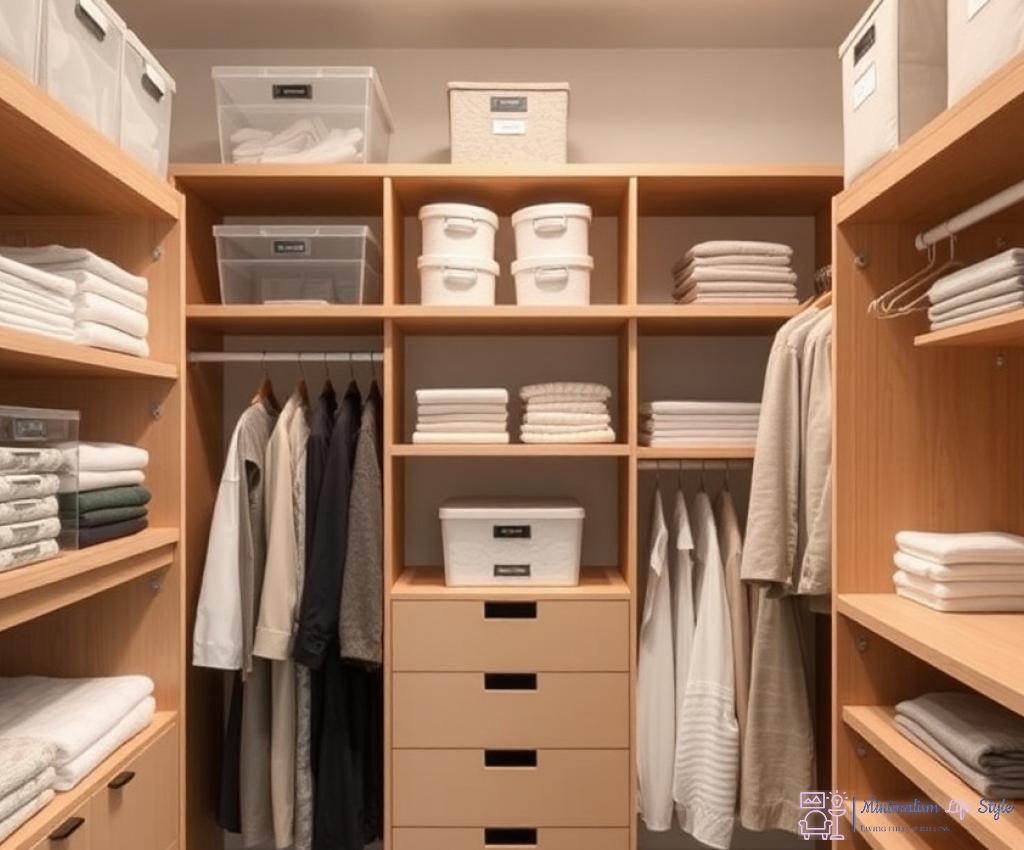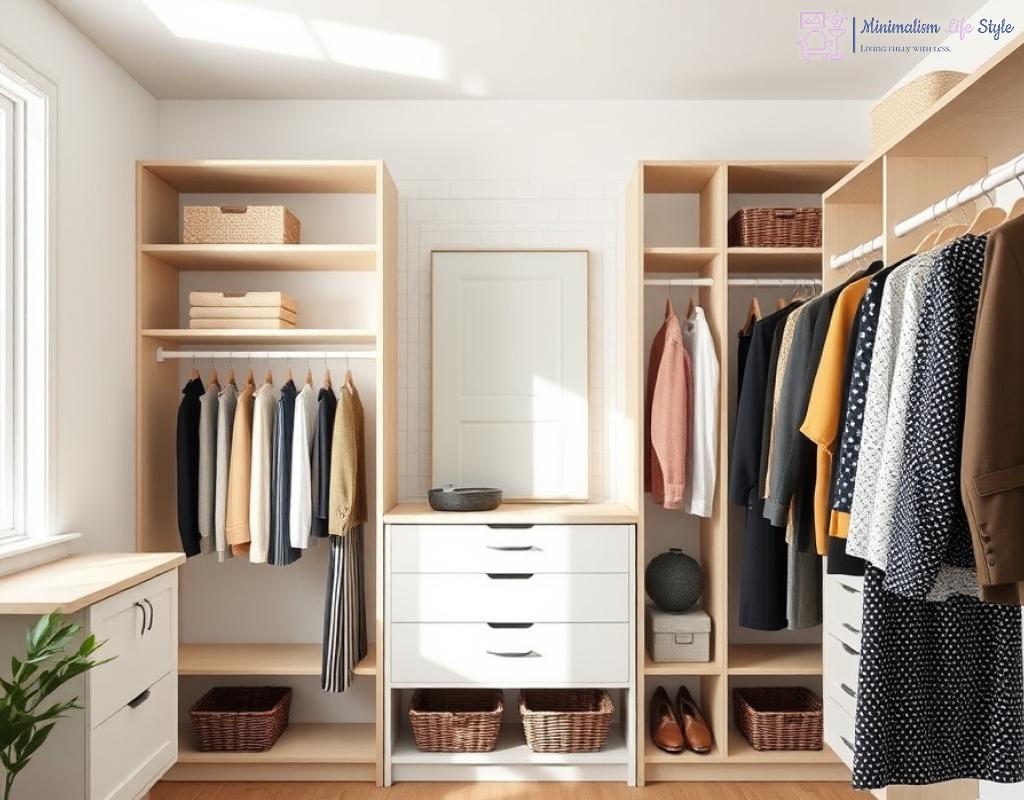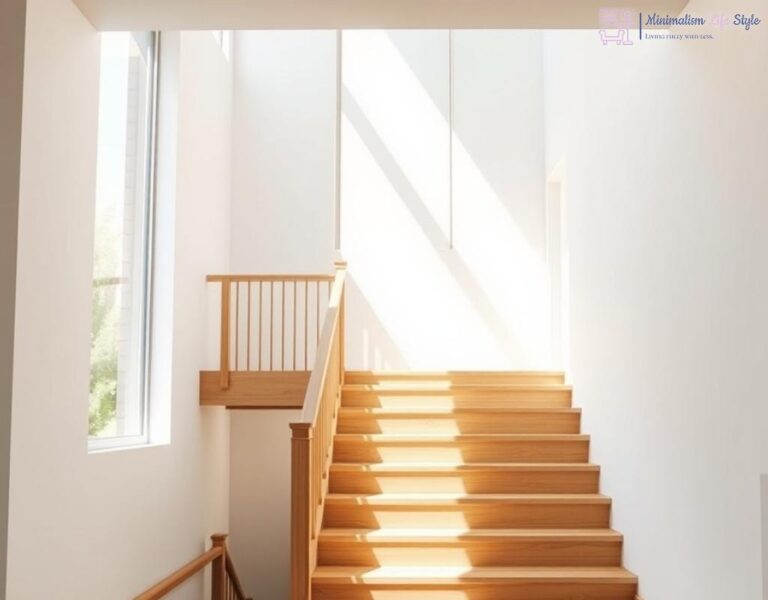Streamlined Storage Solutions

Embrace the Essence of Minimalism
In a world where clutter often reigns, the concept of minimalism offers a refreshing breath of fresh air. A minimal home closet design is not just about aesthetics; it’s about creating functional spaces that promote peace and efficiency. By embracing streamlined storage solutions, you can transform your closet into a sanctuary of organization and simplicity, allowing you to easily find what you need without the chaos.
Creative Strategies for Decluttering
Before diving into the world of streamlined storage solutions, it’s crucial to declutter and curate your wardrobe. This is where creativity meets functionality. Instead of merely tossing items into your closet, consider the following strategies:
- Evaluate Your Wardrobe: Assess each item and ask yourself if it brings you joy or serves a purpose.
- Categorize: Group similar items together, such as clothing, accessories, and shoes.
- Utilize Vertical Space: Install shelves that reach the ceiling or use hanging organizers to maximize storage.
- Rotate Seasonal Items: Keep only current season clothes accessible, storing others out of sight.
Innovative Storage Solutions That Shine
After decluttering, it’s time to implement innovative storage solutions that can enhance the functionality of your closet. Here are some popular options that can help streamline your storage:
| Storage Solution | Description | Benefits |
|---|---|---|
| Modular Shelving | Customizable shelving units that can adapt to your needs. | Flexible and efficient use of space. |
| Drawer Organizers | Dividers for drawers to separate items. | Quick access to small items without the mess. |
| Over-the-Door Racks | Space-saving racks that utilize the back of doors. | Extra storage without taking up floor space. |
| Clear Bins | Transparent storage bins for visibility. | Easy to see contents, reducing the time spent looking for items. |
| Hooks and Pegboards | Wall-mounted solutions for bags and accessories. | Stylish display while keeping items accessible. |
Implementing these solutions not only keeps your closet organized but also enhances the overall aesthetic of your home. By investing in a few key storage solutions, you can enjoy a clutter-free environment that promotes calmness and creativity.
Essentials of Minimalist Wardrobe Planning
In the pursuit of a minimalist lifestyle, wardrobe planning becomes an art form that transcends mere fashion choices. It merges function with style, allowing for a curated collection that speaks to your personal taste while maintaining simplicity. This approach not only streamlines your daily routine but also aligns with the core principles of minimalism: quality over quantity and intentionality in every choice.
Curate with Intention
Every piece in your wardrobe should reflect your identity and lifestyle. Curating your clothing collection involves thoughtful consideration of each item’s purpose and significance. Ask yourself:
- Does it fit well? Ensure that each item complements your body shape and size.
- Is it versatile? Choose clothing that can be mixed and matched for various occasions.
- Does it resonate with your style? Opt for pieces that make you feel confident and authentic.
This intentional curation helps eliminate unnecessary clutter, paving the way for a wardrobe that serves you effectively.
Quality Over Quantity
Investing in high-quality pieces is a cornerstone of minimalist wardrobe planning. While it may be tempting to fill your closet with fast fashion, choosing durable items that withstand the test of time is far more beneficial. Here’s why:
- Longevity: Quality pieces last longer, reducing the need for frequent replacements.
- Less Waste: By purchasing thoughtfully, you contribute to a more sustainable fashion ecosystem.
- Timeless Style: Classic designs never go out of fashion, ensuring you remain stylish regardless of trends.
A minimalist wardrobe thrives on fewer, well-chosen items that elevate your style without overwhelming you.
Maintain the Minimalist Mindset
Once your wardrobe is curated and filled with quality items, maintaining this minimalist mindset is essential. Regularly assess your collection, ensuring it continues to serve your current lifestyle and preferences. Consider implementing a seasonal review where you:
- Evaluate new purchases against your established criteria.
- Donate or recycle pieces that no longer resonate.
- Keep a wishlist for items you genuinely need, preventing impulse buys.
By adopting these practices, you cultivate a wardrobe that not only simplifies your life but also empowers you to express your individuality with confidence.
Transforming Small Spaces with Smart Design
In the realm of minimal home closet design, transforming small spaces into functional areas is both an art and a science. Maximizing the potential of limited square footage requires innovative thinking and smart design choices that cater to both aesthetics and utility. By understanding how to manipulate space effectively, even the tiniest of closets can become a haven of organization and style.
Embrace Multi-Functional Furniture as a cornerstone of your design strategy. Opting for pieces that serve dual purposes can dramatically increase the functionality of your closet. For instance, a well-designed ottoman that doubles as a storage unit or a foldable ironing board that can be tucked away when not in use can make a significant impact. These smart solutions not only save space but also contribute to a cleaner, more streamlined environment.
Lighting and Color Schemes play pivotal roles in transforming small spaces. Utilizing lighter colors can create an illusion of openness, making your closet feel larger than it is. Pairing this with strategically placed lighting, such as LED strips or small spotlights, can enhance visibility and add depth. When the right lighting is combined with a thoughtful color palette, the result is a welcoming space that invites users to engage with it rather than shy away from clutter.
Another essential aspect of achieving functional simplicity lies in customization and adaptability. Modular storage solutions, such as adjustable shelves or movable racks, allow for personal adaptation based on your changing needs. This flexibility ensures that your closet can evolve alongside your wardrobe, accommodating new styles or seasonal changes without the burden of extensive reorganizing. Additionally, incorporating pull-out drawers or baskets can streamline access to smaller items, reducing the chaos typically associated with traditional shelving.
| Design Element | Benefit |
|---|---|
| Multi-Functional Furniture | Maximizes utility while minimizing clutter |
| Lighter Color Schemes | Creates an airy feel, making spaces appear larger |
| Modular Storage | Adapts to your evolving needs for sustained organization |
Ultimately, the journey toward a minimal home closet design that emphasizes functional simplicity is about making thoughtful choices that enhance your daily life. By prioritizing smart design elements that champion efficiency and style, anyone can master the art of transforming small spaces into beautifully organized retreats.
Choosing the Right Materials for a Clean Look
When it comes to achieving a minimalist closet design, the choice of materials plays a pivotal role in establishing a clean and cohesive look. The right materials not only enhance the aesthetic appeal of your space but also promote durability and functionality. By selecting materials that align with your minimalist vision, you can create an environment that feels both serene and organized.
Material Matters: Prioritizing Quality and Aesthetics
In your quest for minimalism, it’s essential to prioritize materials that exude quality while maintaining a simplistic elegance. Opting for well-crafted materials can elevate the overall design of your closet. Consider the following options:
- Natural Wood: Offers warmth and timelessness, providing a classic look that complements various design styles.
- Metal Accents: Use sleek metal finishes for shelving and hardware to add a modern touch while ensuring durability.
- Glass Elements: Incorporate glass doors or shelves to create an airy feel, allowing visibility while minimizing visual clutter.
- Fabric Bins: Choose high-quality fabric storage for softening hard edges, contributing to a cozy atmosphere without sacrificing organization.
Creating Cohesion: Color and Texture Considerations
While materials are important, the colors and textures you choose can either enhance or detract from the minimalist aesthetic. A cohesive color palette is vital in achieving that clean look. Here’s how to create visual harmony:
- Neutral Tones: Stick to a palette of whites, grays, and soft pastels that promote tranquility and make spaces feel expansive.
- Textural Variety: Mix different textures, such as smooth wood with woven fabrics, to keep the design engaging while still maintaining simplicity.
- Consistent Finishes: Ensure that hardware and fixtures have a uniform finish, whether matte or shiny, to avoid visual chaos.
Visualizing Your Choices: The Impact of a Thoughtful Design
Ultimately, the materials you select for your closet should align with your vision of functional simplicity. To help you visualize the impact of these choices, consider the following table that compares common materials based on their benefits:
| Material | Benefits | Considerations |
|---|---|---|
| Natural Wood | Timeless appeal, durability | Can be heavier and more expensive |
| Metal | Modern look, strong support | May require additional treatment to avoid rust |
| Glass | Creates openness, stylish | Requires regular cleaning to maintain clarity |
| Fabric | Softens hard lines, diverse patterns | May wear down over time, depending on quality |
By carefully choosing the right materials, you can craft a closet that embodies functional simplicity while radiating an aesthetic that is both clean and inviting. Your closet can become more than just a storage space; it can be a stylish reflection of your minimalist lifestyle.
Maximizing Functionality with Minimal Decor
In the pursuit of a minimalist lifestyle, the challenge often lies not just in what to keep but how to utilize what you have effectively. When it comes to closet design, functionality should reign supreme, even when decor is minimal. This balance between efficiency and aesthetics can be achieved through strategic organization, thoughtful design choices, and the art of restraint.
Mindful Organization: The Key to Efficiency
To maximize the functionality of your closet, it’s essential to adopt a mindful approach to organization. This involves more than simply placing items in a designated space; it’s about evaluating how you interact with your belongings. Consider implementing the following strategies:
- Assess Accessibility: Place frequently used items at eye level and within easy reach, while seasonal or less-used items can be stored higher or in harder-to-reach spaces.
- Implement Clear Labels: Use labels on bins and shelves to identify contents, reducing time spent searching for items and maintaining order.
- Use Uniform Hangers: Opt for matching hangers to create a cohesive look, which not only enhances visual appeal but also saves space.
Design Elements That Enhance Functionality
In minimal closet design, every element should serve a purpose. Choosing design elements that enhance functionality while maintaining a clean aesthetic is fundamental. Here are some effective design choices:
- Open Shelving: This promotes visibility and access, encouraging you to keep only what you need and love.
- Sliding Doors: Perfect for small spaces, sliding doors eliminate the need for clearance and allow for seamless access.
- Integrated Lighting: Incorporating LED lights can illuminate your closet, making it easier to find items while adding a modern touch.
Embrace Minimal Decor for a Calming Atmosphere
Finally, the decor in a minimalist closet should echo the principles of simplicity. Opt for a few decorative touches that align with your personal style without overwhelming the space. Consider:
- Natural Elements: Incorporate plants or wooden accents to introduce warmth and life to your closet.
- Artful Displays: Showcase a few select pieces that speak to your personality, such as framed photos or art, which can serve as a personal touch.
- Neutral Color Schemes: Stick to a palette of soft, muted colors to promote tranquility and cohesiveness.
By focusing on these core aspects of functionality and minimal decor, you can create a closet that not only meets your storage needs but also serves as a serene and organized retreat. In a world often filled with chaos, a well-designed closet can provide a welcome sense of simplicity and clarity.




